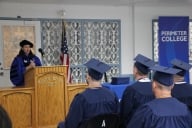You have /5 articles left.
Sign up for a free account or log in.
“If not now, I say, when?” This was the answer given by Shirley Chisholm when running for the for the Democratic Party’s presidential nomination in 1972. One of the three women profiled by Ellen Fitzpatrick in her book The Highest Glass Ceiling: Women’s Quest for the American Presidency, as the first black woman to attempt the nomination, Chisholm had both sexism and racism to content with.
But, as evidenced by the above quote, the racism and sexism that plagued Chisholm’s campaign did not deter her much; at least in Fitzpatrick’s retelling. Much like the other women profiled in The Highest Glass Ceiling, Margaret Chase Smith and Victoria Woodhull, Chisholm was no stranger to firsts, or the prejudice accompanying them. When Margaret Chase Smith was elected to the House of Representatives, she would use public restrooms or walk back to her office to use the restroom in her office, as there were no restrooms for women near the House floor. (In fact women didn’t get a restroom off the House floor until 2011; the Senate got one in 1993.) When Victoria Woodhull ran for President in 1872, women did not yet have the vote.
Indeed, The Highest Glass Ceiling is peppered with instances of prejudice and discrimination so frequent that they become the thread with which one can trace the similarities in the stories of three otherwise extremely different women. For example, although on opposite sides of the aisle, both Margaret Chase Smith (Republican) and Shirley Chisholm (Democrat) had very efficacious careers in Congress. Not only did they stand on numerous committees and sponsor countless pieces of legislation, they also spoke out on the most challenging issues of their time. Only only four months into his anti-Communist campaign, Margaret Chase Smith gave a “Declaration of Conscience” speech against Joseph McCarthy’s tactics, calling on Republicans and Democrats alike to stop “being tools and victims of totalitarian techniques -- techniques that, if continued her unchecked, will surely end what we have come to cherish as the American way of life.” Although only seven other Congressmen formally supported her at the time, financier and political consultant Bernard Baruch is reported to have said that if a man had delivered Smith’s speech, “he would be the next President of the United States.”
Similar anecdotes are recounted frequently throughout the three women’s chapters, although the peculiarities of Victoria Woodhull’s campaign make her story somewhat of an outlier (the Spiritualism, the fact that she promoted herself as a clairvoyant, the relationship with Cornelius Vanderbilt). This, of course, may be due to the political climate at the time, and the fact that she was running for President a half a century before women had the vote, and a full century before Chisholm.
I was finishing this book while Hillary Clinton was in Philadelphia, accepting her party’s presidential nomination. I’ll admit that reading The Highest Glass Ceiling made me more excited about the historic nomination than I may have otherwise been. No doubt this was part of Fitzpatrick’s publisher’s aim -- to capitalize on the fervor around the first woman candidate of a major political party. It also makes clear that so little has changed in the national political arena; Clinton is still on the receiving end of incredible levels of sexism, routinely receiving public judgments that would never be leveled at a male candidate. However, like her predecessors Woodhull, Chase Smith, and Chisholm, she has also remained fairly unswayed. Perhaps we will someday get to a point where the level of strength and conviction exhibited by these women won’t be requisite for women candidates for president. For the past century and a half, though, the fire, resilience, and determination that marked all of these women’s political lives have remained much needed. And, I might add, they do make for a great story.
The Highest Glass Ceiling: Women’s Quest for the American Presidency
By Ellen Fitzpatrick
318 pp. Harvard University Press.








